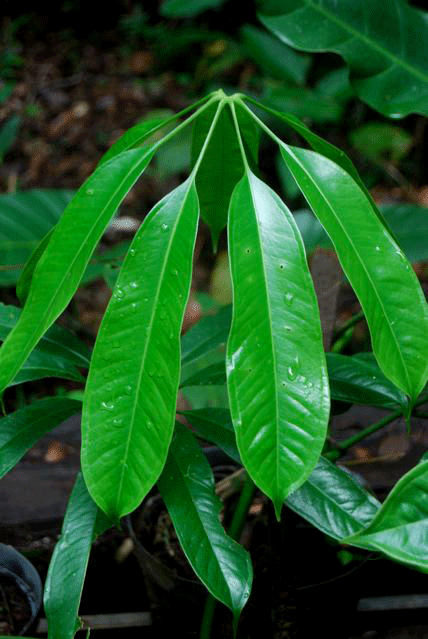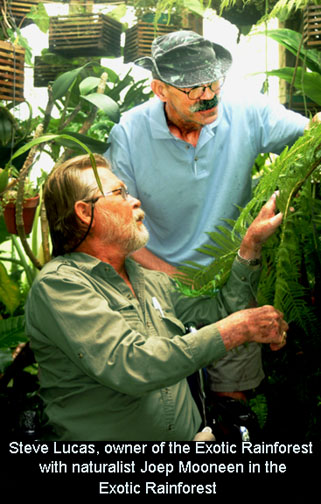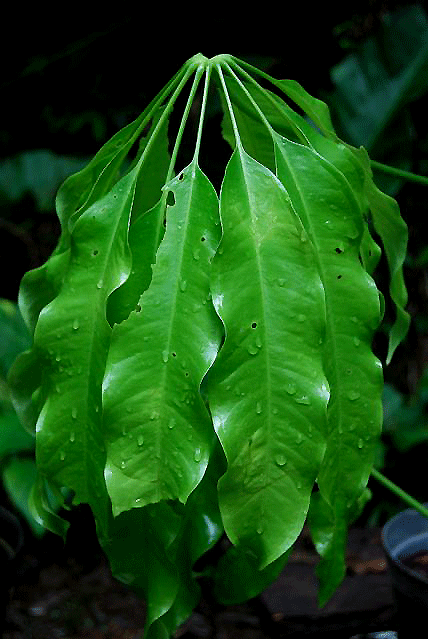![]()
Aroids and other genera in the Collection
Take the Tour Now?
Orchids
The
Exotic Rainforest
Plants in
the Exotic Rainforest Collection
The images on this website are copyright protected. Please contact us before any reuse.
Detailed information on Growing Anthurium
Species Click this Link
Within our collection we have many species of Anthurium. If you are seeking other photos, click this link:
New: Understanding, pronouncing and using Botanical terminology, a Glossary
Anthurium eminens Schott

Synonym: Anthurium wittianum Engl.
Emerald Jungle Village, French Guiana
Anthurium eminens
was first published to science in 1855. Based on information
provided by Dutch naturalist Joep Moonen (yupe or jupe), who guides
botanists and tourists into the rain forest of French Guiana,
northern Brazil, and
 Suriname, Anthurium eminens is considered
a rare species in French Guiana. Both an epiphyte (ep-a-FIT) and a
hemiepiphyte (hem-a-EPA-fit), the species grows on the trunks of trees. An epiphyte
is a plant that grows upon another plant as a result of a seed being
deposited on the tree by a monkey, bird or other rain forest
inhabitant in their droppings. A hemiepiphyte is similar but can
also climb the tree as a result of a seed that has germinated in the
ground. The species is normally found 3 meters (10 feet) or higher
up the host tree and is a member of Anthurium section
Dactylophyllium,
a group with palmately compound leaf blades.
Suriname, Anthurium eminens is considered
a rare species in French Guiana. Both an epiphyte (ep-a-FIT) and a
hemiepiphyte (hem-a-EPA-fit), the species grows on the trunks of trees. An epiphyte
is a plant that grows upon another plant as a result of a seed being
deposited on the tree by a monkey, bird or other rain forest
inhabitant in their droppings. A hemiepiphyte is similar but can
also climb the tree as a result of a seed that has germinated in the
ground. The species is normally found 3 meters (10 feet) or higher
up the host tree and is a member of Anthurium section
Dactylophyllium,
a group with palmately compound leaf blades.
 The
spathe of Anthurium eminens is green with a purple tinge but itself
is not a "flower". The spathe is simply a
modified leaf. The spadix at its center vaguely resembles an
elongated pine cone. The
spadix is a spike on a thickened fleshy axis which can produce tiny
flowers. Once the female flowers on the spadix have
been fertilized by an insect, normally a beetle, they produce
berries which in Anthurium emines are purple to purple-red
or sometimes a purplish violet. When "in fruit", those berries
contain the seeds of the aroid. When the fruit is produced the
inflorescence is known to a botanist as an infructesence.
The
spathe of Anthurium eminens is green with a purple tinge but itself
is not a "flower". The spathe is simply a
modified leaf. The spadix at its center vaguely resembles an
elongated pine cone. The
spadix is a spike on a thickened fleshy axis which can produce tiny
flowers. Once the female flowers on the spadix have
been fertilized by an insect, normally a beetle, they produce
berries which in Anthurium emines are purple to purple-red
or sometimes a purplish violet. When "in fruit", those berries
contain the seeds of the aroid. When the fruit is produced the
inflorescence is known to a botanist as an infructesence.
Anthurium eminens has been collected in Bolivia, Brazil, Colombia, Ecuador, French Guiana, Suriname, Venezuela and Peru. Specimens have been observed by field botanists from from 70 meters to over 2100 meters (230 to almost 6700 feet) above sea level. Anthurium eminens is a wide spread species and although rare in French Guiana is often observed in the other portions of its natural range.
 In the field notes of
aroid botanist Dr. Thomas B. Croat Ph.D., P.A. Schulze Curator of
Botany at the Missouri Botanical Garden in St. Louis, MO, Dr. Croat
states the leaf blades of Anthurium eminens are medium to
dark green on the adaxial (upper) leaf surface and are matte to semi-glossy.
The leaves are slightly paler in color on the abaxial (underside) of the blade
and the blades are subcoriaceous. Subcoriaceous is a description of
the thickness of the leaf blade and indicates the blade is just less
than leathery to the touch. When a new leaf emerges it is
surrounded by a sheath like covering known as a cataphyll. Once the
cataphyll dries the base of its fibers remain on the Anthurium.
The petioles which support each leaf (often called stems) can be
terete to just less than terete (round to less than round) and have
also been observed to be shaped like a letter "U" when cut as a
cross section.
In the field notes of
aroid botanist Dr. Thomas B. Croat Ph.D., P.A. Schulze Curator of
Botany at the Missouri Botanical Garden in St. Louis, MO, Dr. Croat
states the leaf blades of Anthurium eminens are medium to
dark green on the adaxial (upper) leaf surface and are matte to semi-glossy.
The leaves are slightly paler in color on the abaxial (underside) of the blade
and the blades are subcoriaceous. Subcoriaceous is a description of
the thickness of the leaf blade and indicates the blade is just less
than leathery to the touch. When a new leaf emerges it is
surrounded by a sheath like covering known as a cataphyll. Once the
cataphyll dries the base of its fibers remain on the Anthurium.
The petioles which support each leaf (often called stems) can be
terete to just less than terete (round to less than round) and have
also been observed to be shaped like a letter "U" when cut as a
cross section.  The images
on this page are the copyrighted property of naturalist Joep Moonen
in
French Guiana. You must seek permission before attempting to
duplicate any image!
The images
on this page are the copyrighted property of naturalist Joep Moonen
in
French Guiana. You must seek permission before attempting to
duplicate any image!
If you enjoy spending time in a rain forest
filled with exotic creatures and extremely rare exotic plant species
Joep Moonen also enjoys introducing people like you to the rain
forests of northeast South America. The Emerald Jungle Village
website can be found at
http://home.planet.nl/~gumamaus/